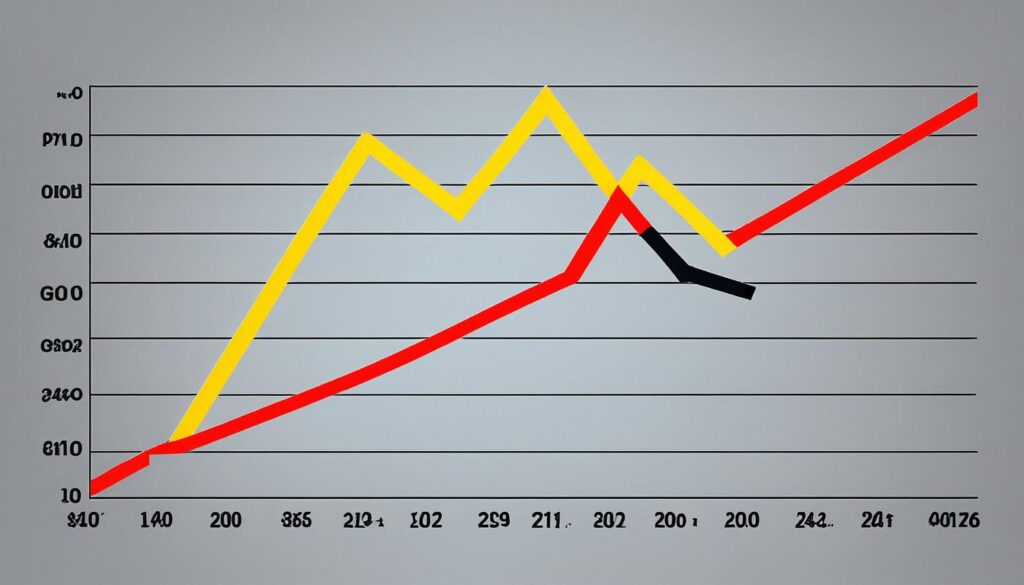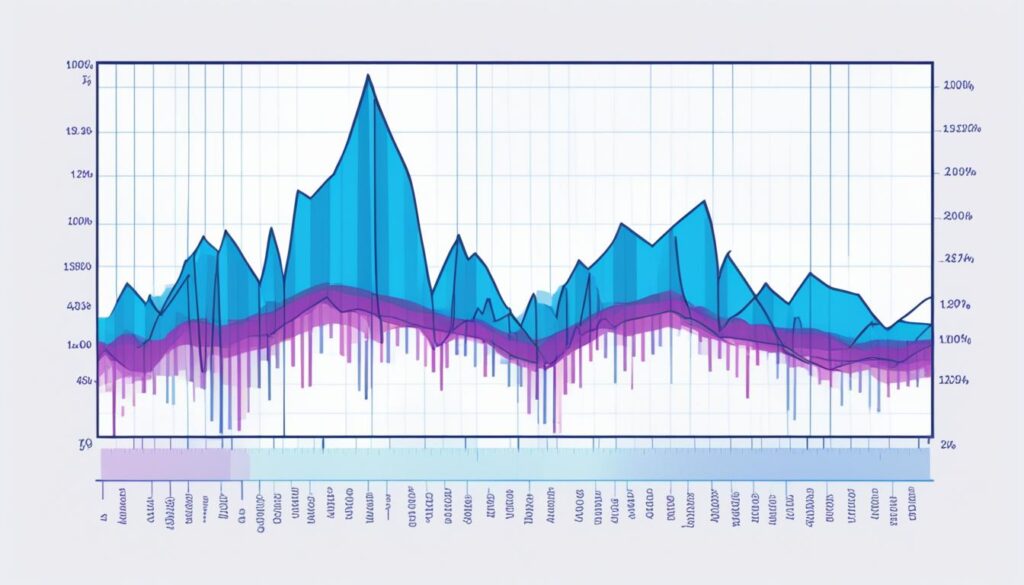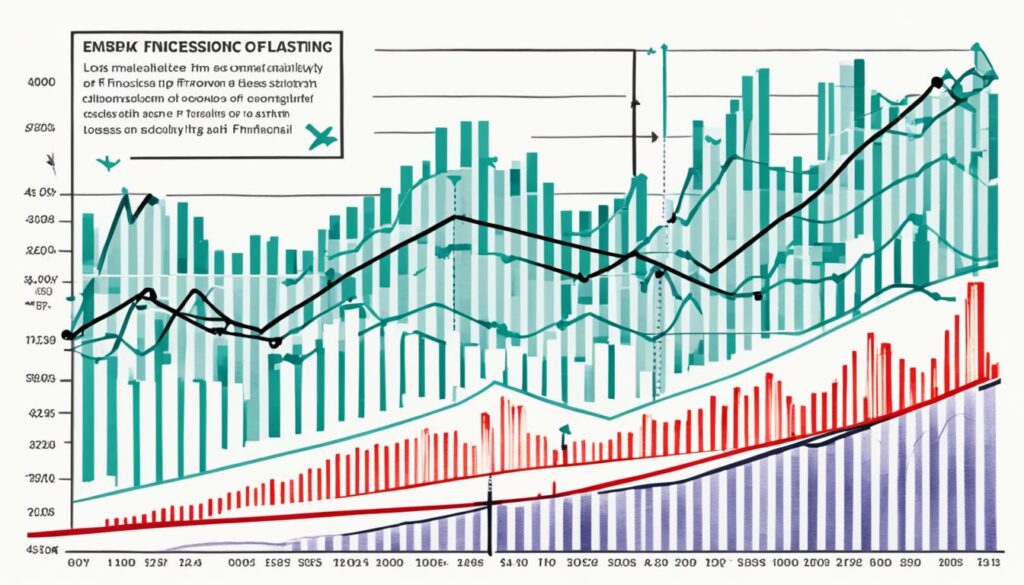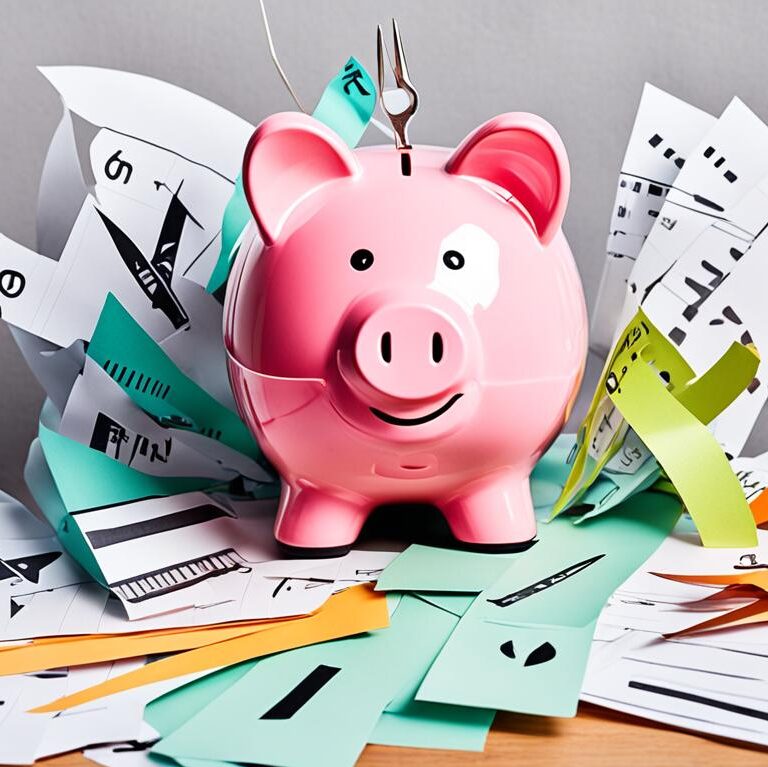“As an Amazon Associate I earn from qualifying purchases.”
Have you heard people talking about an ‘economic recession’ at coffee shops or dinners? It’s like noticing the season change from fall to winter. You can feel the atmosphere shift and wallets getting tighter. A recession means the economy is really struggling. It affects everything from jobs to our daily joys. By understanding recessions, we learn how they influence our lives and society.
The National Bureau of Economic Research studies these downturns. They pinpoint when recessions happen by looking at jobs and how much people spend. Knowing about these downturns gives us power. It helps us stay prepared during uncertain times.
Key Takeaways
- Gaining a grasp on the concept of an economic recession beyond the common clichés.
- Recognizing how recession analysis helps anticipate challenges and prepare effectively.
- Understanding the real-world recession effects that manifest in job markets and everyday budgets.
- Learning the roles retrospective economic data plays in declaring recessions.
- Exploring the broader impact of economic downturns on consumer confidence and spending.
The Basic Concept of a What Is a Recession Explained
Understanding what is a recession means looking deeper than common views. A true recession definition goes beyond just two quarters of falling GDP. This simple idea misses the complex indicators and signs of a economic downturn.
Standard Definition and Common Misconceptions
A lot of people think a recession is just when the GDP drops for two quarters in a row. But the National Bureau of Economic Research (NBER), a major authority, sees it differently. They consider various factors like job numbers and retail sales, to give a fuller picture of a nation’s economic health.
Historical Context of Economic Recessions
Economic growth isn’t always straight forward. History shows cycles of ups and downs. The good news? Since the 1960s, recessions have become shorter and not as common. This hints at a brighter outlook for future economic downturns.
Exploring historical trends helps us understand what is recession and prepare for economic changes.
Looking at past economic cycles shows recessions are part of any economy. It’s critical to think about the recovery that follows, which can set the stage for new growth. – NBER
Studying past economic downturns tells us about the challenges faced and the economy’s ability to bounce back and grow.
To really get the concept of a recession, one must see its many layers. It’s about more than just the definitions in books. It’s about understanding the real-life complexities of an economic downturn.
Evaluating Economic Health: Recession Indicators
To understand economic health, we look at different recession indicators. These factors help us grasp how they impact the gross domestic product and economic well-being.
Navigating Through Negative GDP
A negative gross domestic product marks economic distress. But the real story lies behind this figure. GDP measures the total value of goods and services. A dip needs further investigation to figure out if it’s a short-term issue or a deep problem.

Economic reports showing GDP downturn raise concerns. Examining the cause, like lower consumer spending, investments, or trade deficits, gives a clearer view of economic health.
Beyond GDP: Employment and Consumer Spending
Employment stats are crucial for assessing an economy’s strength. Job loss following GDP decreases signals serious economic issues. But if jobs are stable or growing, the economy might be stronger than GDP alone shows.
Consumer spending shows how confident people feel about their finances. A drop suggests people are worried about tough times ahead. But an increase means people believe the economy is getting better. Watching these trends helps us understand where the economy is headed, beyond just GDP numbers.
| Indicator | What It Shows | Relevance to Recession |
|---|---|---|
| Gross Domestic Product | Overall economic output | Primary benchmark for economic growth/contraction |
| Employment Rates | Job market health | Lagged indicator reflecting hiring/firing trends |
| Consumer Spending | Household financial confidence | Indicates willingness to inject money into the economy |
| Industrial Production | Manufacturing, mining, and utility output | Sign of business sector confidence and demand |
Understanding various recession indicators helps everyone. It lets investors, policy makers, and citizens make sense of economic conditions. Accurate analysis of economic data is key to knowing economic health and predicting recessions.
What Is a Recession
A recession means a big drop in economic activity that affects all parts of the economy. The recession effects are felt daily. Businesses make less stuff, workers worry about their jobs, and less money is spent. To really get what a recession does, we need to look closely at how deep and wide its impact goes.
The effects of a recession are far-reaching. They impact everything from jobs in your town to global trade. It’s not just about the economy shrinking, as seen in GDP numbers. It’s also about people losing jobs, factories slowing down, and people buying less. These changes give us a clearer picture of what a recession means in real life.

- Economic downturns force industries to reevaluate their production capacities, often leading to decreased output and investments.
- The ripple effects of reduced industrial and business activities impact the employment landscape, possibly escalating into a rise in unemployment rates.
- On a micro level, recessions can result in diminished household wealth, constraining consumer spending and saving behaviors.
This cycle of challenges leads to economic adjustment. Both businesses and consumers must adapt to a changed money landscape. To move forward, we need strong recession analysis. It guides policy choices and planning that are crucial for bouncing back.
Understanding recessions is key for everyone, both big businesses and everyday people. The health of global markets can depend on how well we handle economic lows. Knowing about downturns and their recession effects on economic activity helps economies stay strong and recover.
Recession Causes: Understanding the Triggers
Recessions impact economies all over the globe. They happen due to various reasons, from sudden shocks to the buildup of financial risks. Understanding recession causes requires looking into different economic theories. This helps to understand what slows down the economy.
The balance between credit growth, money supply, and how confident people feel plays a big role. If these aspects are not in harmony, the economy might start to shrink. The health of our financial system depends on these factors.
“Understanding the roots of recession requires a careful analysis of both macroeconomic trends and microeconomic behaviors.”
Let’s look at some main causes of recessions:
- Industries changing, which forces workers and money to move differently
- Economies that get too hot and create bubbles that eventually pop
- Quick jumps in oil prices that affect businesses and customers alike
- How people feel about the market, which can change spending and investing
Looking at these causes helps us see how recessions start. Knowing about them is crucial to try and stop a recession from happening. The key is to foresee and lessen these financial risks.

By learning about what is a recession, you get insights into smart financial planning and risk control. It’s all about knowing the risks and making smart choices. To have a stable economy, we must manage these risks well. This requires understanding economic concepts and using data wisely.
Characterizing Recessions and Their Impact on Society
A recession hits economic output and consumer spending hard. These downturns ripple through society, creating tough challenges. Knowing how they affect us helps in fighting their consequences.
Long-term vs. Short-term Effects
Recessions quickly impact us all. After the economy peaked in February 2020, it fell sharply. The National Bureau of Economic Research shows how fast downturns can happen. Recession vs depression
Soon, people lose jobs and spend less. This less spending makes businesses cut costs by letting go of workers. This cycle makes things worse.
Recession Impact on Employment and Household Wealth
The long-term effects hit society deeply. The data shows struggles with job loss and lower wealth. what is the official definition of a recession Key measures, like real income and jobs, signal our economic health. They show the deep financial hits we face over time.
Experts wait on data to fully understand economic cycles. They know the lasting effects, like lost savings and jobs, linger even as things seem to get better.
This table shows the harsh truth of what is a recession with recent data:
| Indicator | Status at Peak (Feb 2020) | Status at Trough (Apr 2020) | Long-term Consideration |
|---|---|---|---|
| Economic Activity | Peaked | Significant Decline | Aggregate Impact, Recovery Trajectory |
| Real Personal Income Less Transfers | Stable | Decreased | Household Financial Health |
| Nonfarm Payroll Employment | Robust | Sharp Decline | Employment Rate, Job Market Recovery |
These stats teach us about recessions and the need to stay strong. Looking at business cycle chronology, we see an economy’s strength is tested in its lowest points.
Differentiating Recessions from Depressions
Understanding economic downturns is key. It’s vital to know the differences between a recession and a depression. These terms are often used interchangeably, but they vary greatly in intensity and duration.
The Scale and Duration of Economic Contractions
The main difference between a recession and a depression is their scale. Recessions are shorter and can be part of the economic cycle. On the other hand, depressions, like the Great Depression, mean extreme decline and last much longer.
To give you a better idea, let’s compare them:
| Characteristic | Recession | Depression |
|---|---|---|
| Duration | Few months to a year | Several years |
| GDP Decline | Moderate decline | Significant, sustained decline |
| Employment | Increased unemployment | Drastically high unemployment rates |
| Recovery Period | Relatively quick recovery | Long, arduous recovery |
Both types of economic contractions deeply affect society. But a depression, like the Great Depression, causes prolonged hardship. Learning from past events is crucial for policymakers to lessen future what is a recession and avoid depressions.
Recession Prediction: Analyzing Patterns and Leading Indicators
Predicting a recession is not easy. It requires looking at past data and identifying leading indicators. The National Bureau of Economic Research defines a recession as a big drop in economic activity that lasts several months. Experts look at consumer spending, industrial production, income, and employment. They check things like the GDP’s contraction, inventory level changes, and payroll employment growth rates.
The Role of the Inverted Yield Curve
The inverted yield curve is a key signal for predicting recessions. It happens when short-term debts pay more than long-term ones, the opposite of what’s usual. An inverted yield curve has often come before recessions. But, it’s vital to look at it with other economic signs for a complete analysis.
Monitoring Market Trends and Economic Indicators
The unemployment rate has been low, at 3.6% recently, but watching the job market closely is still key. The Sahm rule indicates a possible recession if the unemployment rate’s three-month moving average goes up by 50 basis points or more. Currently, it’s at zero. The complexity of market trends requires close attention, especially since recession risks are often suggested by trends.
Private domestic final demand is an important indicator too, with a recent growth of 3.0% in consumer spending and fixed investments. Although predicting economic changes is complex, keeping up with these indicators is crucial. It helps in forecasting recessions and getting ready for them.
| Economic Indicator | Q1 Data | Q2 Data | Notes |
|---|---|---|---|
| Real GDP Contraction | 1.6% | N/A | Mainly due to inventory and export fluctuations |
| Payroll Employment Growth | 4.7% | 3.4% | 1.1 million jobs created in Q2 |
| Unemployment Rate | 3.6% | 3.6% | Remained stable for four months |
| Private Domestic Final Demand | 3.0% | N/A | Includes consumer spending and fixed investment |
Recession Recovery: Policies and Measures to Mitigate Damages
When an economy faces a downturn, it’s crucial to take action fast. Governments and central banks use fiscal policies and monetary policies. These tools help address the recession’s specific challenges.
Fiscal Responses to Economic Downturns
Governments can boost the economy and protect people from the worst impacts. They can increase spending on things like roads, schools, and hospitals. They can also adjust taxes to increase the money businesses and consumers have to spend.
Another key step is to extend unemployment benefits. This support helps those without jobs and keeps people spending money. What is a recession These fiscal steps can target the areas and people hit hardest by the downturn.
Strategic Monetary Policies for Recovery
Central banks can lower interest rates to make borrowing cheaper. This encourages businesses to invest and people to buy things. They can also put more money into the economy through quantitative easing. This stabilizes financial markets and keeps credit flowing.
Innovative tools beyond cutting interest rates are also available. These tools ensure money keeps moving and supports economic growth.
Fiscal and monetary policies are critical for economic recovery. Yet, their success depends on how and when they are applied. Their interaction needs careful management to avoid future financial issues.
Understanding these strategies is important for those in the market. Recognizing how recovery measures impact the economy and financial markets is key. Keeping an eye on these policies and measures shows how the economy is improving.
Conclusion
Through this journey into economic downturns, you’ve learned what is a recession and how complex a recession is. It’s not just about numbers. It involves understanding how society gets affected too. The link between economic health and our communities shows why preventing recessions is key. It helps keep everyone’s financial future safe.
You now see a recession is more than just GDP falling. It’s shaped by many factors like market changes, world events, and how people feel. Knowing the difference between a recession and depression helps in planning. This is especially important for those making policies and for banks. It guides them in making decisions that help us recover from downturns.
This knowledge prepares you to look deeper into economic trends and recovery plans. Being proactive and strategic is vital. It helps us bounce back faster from tough times. Staying alert and flexible when facing economic challenges is key. It promotes stability and growth as our main aims.
FAQ
What is a recession the standard definition of a recession?
How is a recession different from an economic downturn?
Why can’t we rely solely on GDP to evaluate a recession?
What are the main factors considered when analyzing economic health during a suspected recession?
What triggers a recession?
How are the short-term and long-term effects of a recession different?
What impact does a recession have on employment and household wealth?
What is a recession differ from depressions in terms of scale and duration?
What economic indicators are monitored to predict a recession?
How do governments and central banks encourage recession recovery?
What is meant by ‘recession prevention’ and ‘economic resilience’?
Why are strategic monetary policies important for economic recovery?
Source Links
- https://www.investopedia.com/terms/r/recession.asp
- https://www.whitehouse.gov/cea/written-materials/2022/07/21/how-do-economists-determine-whether-the-economy-is-in-a-recession/
- https://www.forbes.com/advisor/investing/what-is-a-recession/
“As an Amazon Associate I earn from qualifying purchases.”

